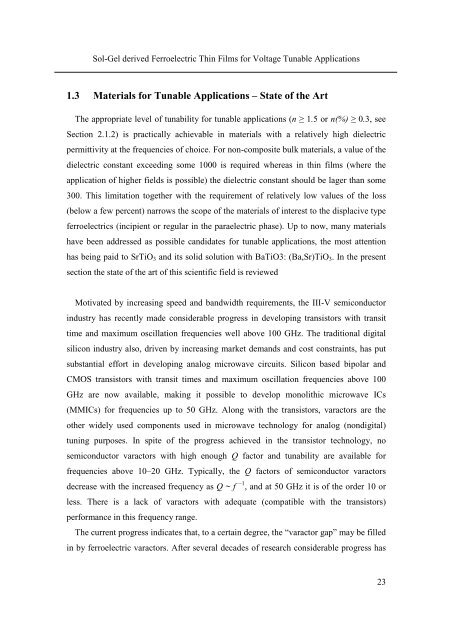PhD Thesis Arne Lüker final version V4 - Cranfield University
PhD Thesis Arne Lüker final version V4 - Cranfield University
PhD Thesis Arne Lüker final version V4 - Cranfield University
Create successful ePaper yourself
Turn your PDF publications into a flip-book with our unique Google optimized e-Paper software.
Sol-Gel derived Ferroelectric Thin Films for Voltage Tunable Applications<br />
1.3 Materials for Tunable Applications – State of the Art<br />
The appropriate level of tunability for tunable applications (n ≥ 1.5 or n(%) ≥ 0.3, see<br />
Section 2.1.2) is practically achievable in materials with a relatively high dielectric<br />
permittivity at the frequencies of choice. For non-composite bulk materials, a value of the<br />
dielectric constant exceeding some 1000 is required whereas in thin films (where the<br />
application of higher fields is possible) the dielectric constant should be lager than some<br />
300. This limitation together with the requirement of relatively low values of the loss<br />
(below a few percent) narrows the scope of the materials of interest to the displacive type<br />
ferroelectrics (incipient or regular in the paraelectric phase). Up to now, many materials<br />
have been addressed as possible candidates for tunable applications, the most attention<br />
has being paid to SrTiO3 and its solid solution with BaTiO3: (Ba,Sr)TiO3. In the present<br />
section the state of the art of this scientific field is reviewed<br />
Motivated by increasing speed and bandwidth requirements, the III-V semiconductor<br />
industry has recently made considerable progress in developing transistors with transit<br />
time and maximum oscillation frequencies well above 100 GHz. The traditional digital<br />
silicon industry also, driven by increasing market demands and cost constraints, has put<br />
substantial effort in developing analog microwave circuits. Silicon based bipolar and<br />
CMOS transistors with transit times and maximum oscillation frequencies above 100<br />
GHz are now available, making it possible to develop monolithic microwave ICs<br />
(MMICs) for frequencies up to 50 GHz. Along with the transistors, varactors are the<br />
other widely used components used in microwave technology for analog (nondigital)<br />
tuning purposes. In spite of the progress achieved in the transistor technology, no<br />
semiconductor varactors with high enough Q factor and tunability are available for<br />
frequencies above 10–20 GHz. Typically, the Q factors of semiconductor varactors<br />
decrease with the increased frequency as Q ~ f −1 , and at 50 GHz it is of the order 10 or<br />
less. There is a lack of varactors with adequate (compatible with the transistors)<br />
performance in this frequency range.<br />
The current progress indicates that, to a certain degree, the “varactor gap” may be filled<br />
in by ferroelectric varactors. After several decades of research considerable progress has<br />
23

















